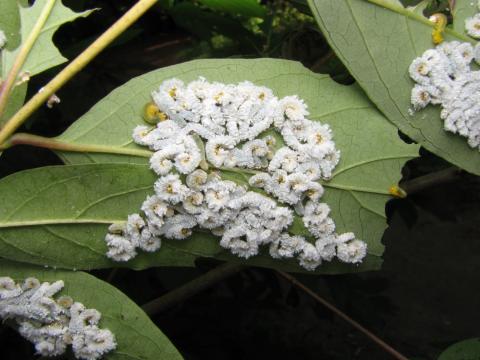What is eating my dogwood leaves?

One of the most common pests of dogwood in New Hampshire is the dogwood sawfly. Adult sawflies are non-stinging, wasp-like insects that usually go unnoticed in the garden. However, sawfly larvae, including conifer sawflies and rose slugs, can cause significant damage to landscape plants. Immature sawfly larvae look very much like caterpillars, but they have a few distinct differences. Sawfly larvae have 6-8 pairs of prolegs (the rear legs attached to the abdomen of the insect), while caterpillars only have 2-5. Additionally, sawflies lack the hooks (crochets) found at the end of caterpillar prolegs, and most have bodies that are hairless.
Dogwood Sawfly Damage
Sawflies generally attack a small range of host plants, and you can narrow down which species you are dealing with based on what type of plant it is eating. Dogwood sawflies feed on the leaves of several shrubby dogwood species including gray dogwood (Cornus racemosa), blood-twig dogwood (Cornus sanguinea) and red osier dogwood (Cornus sericea). The larvae have chewing mouthparts that create sizable holes in leaves. Dogwoods that have large chunks missing from their leaves are probably host to at least a few sawfly larvae.
Dogwood sawflies can create significant defoliation, largely because they feed in groups. It is typical for a dozen or more larvae to collectively munch on the same leaf. Despite this gregarious behavior, they often go undetected because they do most of their feeding on the undersides of dogwood leaves. Thus, it’s important to always check beneath leaves if you suspect that insects might be feeding on a plant. Unchecked, heavy populations of dogwood sawflies can cause significant defoliation.
Identification & Lifecycle
Adult dogwood sawflies emerge from late May through July and lay eggs on dogwood leaves. As the eggs hatch, the larvae feed on foliage between July and September. Dogwood sawflies go through several stages of development, or instars, before they molt into adults. In the second life stage, the larvae appear white and slightly fuzzy due to a waxy material they exude. When they aren’t actively feeding, the larvae will curl up on themselves and look like bird droppings at a quick glance. As the larvae continue to develop, they lose their white coating and become greenish-yellow with black spots. By the time they are fully mature, dogwood sawfly larvae are about an inch long.
Control
Since sawflies can cause significant aesthetic damage and have the potential to reduce plant vigor if left unchecked, monitoring for them in the spring is essential. Small numbers of dogwood sawflies can be hand-picked from leaves and either squished or drowned in a bucket of soapy water. Heavier infestations may warrant the application of a low-impact, registered insecticide such as insecticidal soap, horticultural oil or spinosad. The key to success with these products is getting good spray coverage on the undersides of dogwood leaves where sawfly larvae prefer to feed. One low-impact insecticide that does not work is Bacillus thuringiensis (Bt), a product that specifically kills moth and butterfly caterpillars. Many residual contact insecticides are also labelled for sawflies but have a greater impact on beneficial insects.
Insecticides tend to be most effective against young, small larvae that are half their full-grown size or less. Large larvae that are nearing maturity aren’t very susceptible to insecticides and should be hand-picked instead.
When working around dogwoods, it is a good idea to wear gloves and long sleeves because the leaves of some species, such as blood-twig dogwood, can give gardeners an itchy rash. Whether hand-picking larvae or spraying, keep your skin covered to avoid brushing up against foliage.
Related Resource(s)
Do you love learning about stuff like this?
SUBSCRIBE TO Granite State Gardening newsletter
Got questions? The UNH Extension Yard and Garden Infoline offers practical help finding answers for your yard and garden questions.
Call toll free at 1-877-398-4769, Monday to Friday, 9 a.m. to 2 p.m., or fill out webform.
